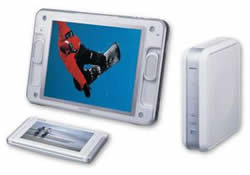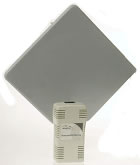There has not been a new Top Level Domains (TLD) since .name came out a couple of years ago. Even that ended up as a bit of a damp squib. But now a collection of nine corporations, have applied to ICANN (Internet Corp. for Assigned Names and Numbers) to form a new domain. Their proposal, .mobile is to be used for mobile applications/devices and will be filed by 15 March 2004.
Nokia is leading some pretty heavyweight companies from the worlds of computing, software, tech manufacturers, mobile phone makers and cellular service providers. The list; Microsoft Corp., Nokia, Vodafone, 3, GSM Association, HP, Orange, Samsung Electronics Co, Ltd. and Sun Microsystems is not only from a diverse range of areas, but are feature companies that normally do not really like each other, like, Nokia, Microsoft and Sun.
If the current application is successful, the current estimate is to have the first names available during the second half of 2005. An independent, separate organisation would run the registry.
This is not the first time Nokia has tried to get some new TLD’s introduced, back in October 2000 they requested, the following form ICANN:-
.mas
.max
.mid
.mis
.mobile
.mobi
.now
.own
At the time they came out with a press release, which sadly they have removed from their site, but thanks to archive.org (nee Way Back Machine), we can find the original release. (Interesting to see their projections for mobile handset, overtaking computers for IP access by 2003). The 2000 applications, clearly was not a success.
UMTS forum has been a big supporter for a Mobile TLD, or M-TLD, as they prefer to call it, and two years ago (March, 2002) they published the findings of ‘Benefits and Drawbacks of Introducing a Dedicated Top Level Domain Within the UMTS Environment’ prepared by Theron business consulting. The Executive Summary – is available to the public, the detail (TOC) is not without registration. The estimated cost of applying for and running the was estimated at less than 3m Euro.
The purpose of the .mobile domain, beyond opening up the domain market to another potential name grab, is not immediately clear. So after reading between various lines and carrying out further research we’ve concluded the following.
It appears that the idea is to limit the people who can get a .mobile name, and by doing this, they hope to ensure that, at the very least, the content is formatted for mobile devices and the service has a level of QoS (Quality of Service). If this will turn out to be a mobile walled garden, a mini-internet, only for mobile devices is not clear. Will .mobile domain only be available for use BY mobile devices, or are people to put their mobile-friendly content on .mobile domains?
Some quotes by the founding partner companies appear to support the walled garden theory.
“We expect that by leveraging the technologies of the Internet, appropriately scaled for mobile scenarios, this initiative will provide the ease of use and efficiency that will significantly fuel mobile Internet usage.”
Brian Arbogast, corporate vice president of the MSN Communications Platform at Microsoft“Creating a unique, standard platform for a mobile Internet environment is a natural next step to enabling new and compelling services for businesses and consumers,”
Felice Swapp, director of strategic initiatives and business development, HP
Forcing publishers to create a whole separate sites to operate under a .mobile domain appears a very expensive route. We would imagine that it would be a much better to define a standard that can be used with any currently existing domain. ie just serve it from the same domain as before but define Digital-Lifestyles.info/mobile or mobile.Digital-Lifestyles.info as the convention.
If the mobile phone owners would get a choice between .mobile-internet or Internet is also not clear.
One things that the mobile industry understand is if each handsets has its own domain name, there are significant issues in maintaining DNS records and monitoring their connection to the Internet – as the phone connect and disconnect so regularly. This lead us to think that they are talking about maintaining a separate DNS system for mobile devices. If they do end up running a separate DNS, Nokia (or their JV company/partners) would become the gatekeeper to and from the mobile world – a very powerful position.
More details of this are bound to popup over the next few weeks, if anything relevant turns up, we will let you know.
The mobile Top Level Domain initiative
Nokia October 2000 application to ICANN
 Akimbo Systems launched their television-via-Internet service yesterday at Demo2004. They are claiming the service will start with over 10,000 hours of video content, organised in to 50 categories, will be pulled from a
Akimbo Systems launched their television-via-Internet service yesterday at Demo2004. They are claiming the service will start with over 10,000 hours of video content, organised in to 50 categories, will be pulled from a  Among the many announcements at CES was an interesting portable 12″ LCD TV screen from Sony, that can be carried around a house and have various content delivered to it from its base station, enabling the showing of video from many different sources, as well as playing music, viewing photos and browsing the Internet. Sony calls it LocationFree™.
Among the many announcements at CES was an interesting portable 12″ LCD TV screen from Sony, that can be carried around a house and have various content delivered to it from its base station, enabling the showing of video from many different sources, as well as playing music, viewing photos and browsing the Internet. Sony calls it LocationFree™.  Their new approach is to provide high-speed connections to a central point, then distribute to households that have uninterrupted, line-of-site to the antenna (picture right) mounted on top of the subscribers rooftop. Labelled as P2MP (Point to MultiPoint), it provides a two-way connection that will, in their words, supply connections of a similar speed to 512k ADSL.
Their new approach is to provide high-speed connections to a central point, then distribute to households that have uninterrupted, line-of-site to the antenna (picture right) mounted on top of the subscribers rooftop. Labelled as P2MP (Point to MultiPoint), it provides a two-way connection that will, in their words, supply connections of a similar speed to 512k ADSL.